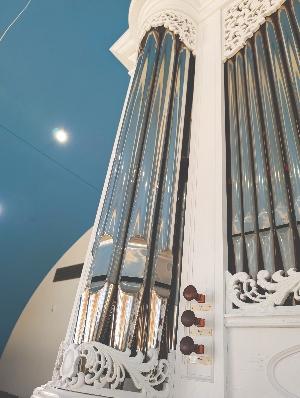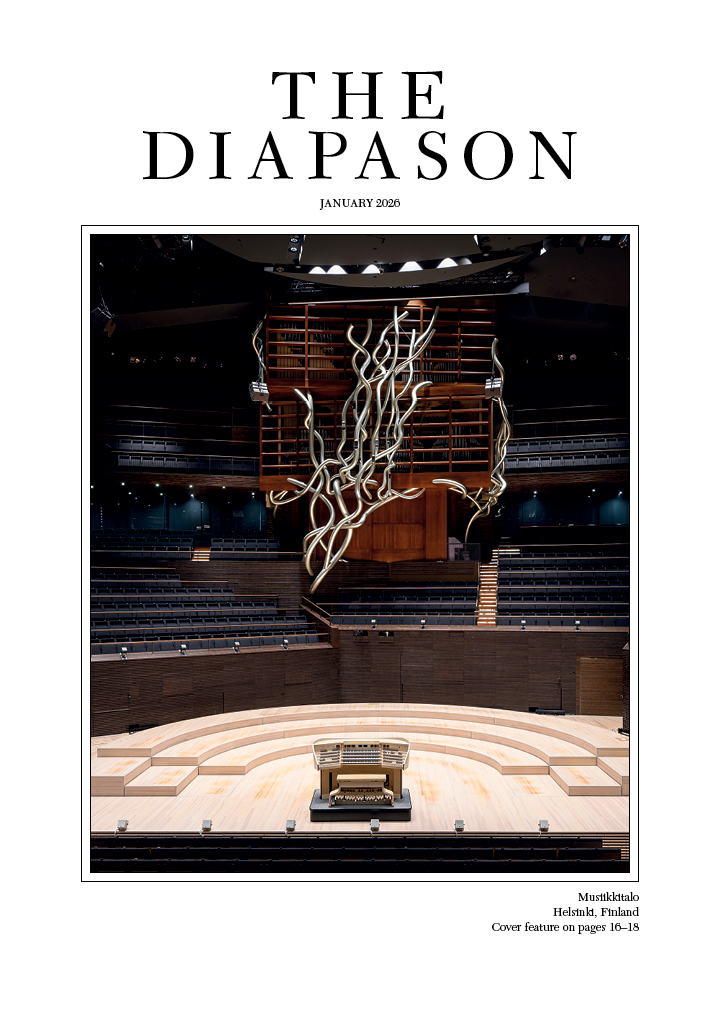J. F. Nordlie Company, Sioux Falls, South Dakota; Saint Charles Borromeo Seminary, Ambler, Pennsylvania, Opus 15

In February of 2023 I received a message from the Very Reverend Ward Simpson, dean of Calvary Episcopal Cathedral of Sioux Falls, on behalf of the Episcopal Diocese of South Dakota. He mentioned a Nordlie pipe organ in Sioux Falls at the Church of the Holy Apostles, that the building and property were to be sold, and wondered whether we could help him find a home for the organ. I thought to myself, “Holy Apostles—why does that sound so familiar?” This instrument is not on our regular tuning schedule, so I thought it must be an organ that was built in our shop before my time with the firm, prior to 2002. “Holy Apostles?” Then it dawned on me. I know the name from the sign in the parking lot; I drive past Holy Apostles every day on my way to our organ shop on the east side of Sioux Falls. An uncomfortable realization set in: there is a Nordlie organ in my hometown, in a church that I drive past every day, that I have never seen in person. There could only be one response to the dean’s message: “When can we meet?”
A few phone calls later, I consulted our resident encyclopedia and tonal director Eric Grane about the organ, and he shared the origin story of this little gem around our breakroom table. In 1807 Conrad Doll of Lancaster, Pennsylvania, built an elegant six-stop, one-manual organ in the Chippendale style for the congregation of Peace Church in Cumberland County, Pennsylvania. The organ was moved in 1887 and alterations made to the case and stoplist. Fast forward to 1974 when the founder of our company John Nordlie was an apprentice with the Noack Organ Company of Georgetown, Massachusetts. The Noack shop won a contract to restore the Doll organ back to its original specification, and John’s first task as apprentice was replication of a wooden set of pipes and documentation of the casework details. Upon his departure from Noack in 1976, he was gifted with the drawings and schematics he had made for the renovation, along with his meticulous notes, and the restored original instrument still stands at Peace Church to this day. Church and organ are owned by the Pennsylvania Historical and Museum Commission (https://www.davidtannenberg.com/Peace_Church.htm).
In 1985 John Nordlie built two replicas of this instrument, opus numbers 15 and 16, on speculation and listed them for sale. These two instruments were not intended to be historical copies of the original, but instead an homage to Doll’s skills as a case designer and builder. It has been suggested that Doll’s skills in woodworking and case design exceeded his skill in producing metal pipes, which likely resulted in his tonal designs relying heavily on wood ranks, and so certain details of the tonal design of the replicas are true to the original, while other areas are explored. The wood ranks in the Peace Church organ are made from walnut from the pitch of 1-3⁄5′ e and up. Wood pipes larger than 1-3⁄5′ e are made of pine. The manual wood ranks in the two Nordlie instruments follow this formula. Where Nordlie deviated from the original tonal design was in the addition of a three-rank mixture to Opus 15, eliminating the 4′ Clarabel open wood stop, and adding a 27-note pedal driven by manual pulldowns. In addition to the tonal changes, Opus 15 also has a tremulant as well as the ability to be played without the electric blower; there is a leather pull-strap, which operates the bellows off to the left side of the case. The specifications for each instrument are below in the yellow stoplist box.
After construction, the two “Dolls” were installed in local churches and made available to their congregations for worship, with the understanding that they could be shown to prospective buyers for sale. Opus 15 first went to the original worship space at Gloria Dei Lutheran Church of Sioux Falls; later it was moved to First United Methodist Church of Sioux Falls, and it finally moved to the Church of the Holy Apostles. Ten years later John received word that the First Presbyterian Church of Greenville, Tennessee, was interested in one of the Dolls and would be sending a scouting party to make a site visit. John gave fair notice to Holy Apostles, who were made plainly aware that the instrument they had worshipped with for nearly a decade could be sold and shipped away in just a few weeks’ time! The leadership at Holy Apostles took matters into their own hands and raised the $56,000.00 to purchase Opus 15 in a matter of days!
The team from First Presbyterian of Greenville made their visit and purchased Opus 16, and it still features prominently in their Christ Chapel. In preparation for this article, I reached out to their music director Ed Logan, and he shared that the organ is played at every 8:30 a.m. service. According to shop lore, full payment for Opus 15 and down payment for Opus 16 arrived in the mail one day apart.
As in all things, the only true constant is change. Over the years the membership at Holy Apostles has changed. The diocese reorganized their congregations as they are known to do, and the building became a place where newly settled congregations from around the world could worship. The organ was used less and less, and eventually the diocese made the decision to reorganize once more.
Dean Simpson asked me to liaise with Father Paul Sneve, who informed me that time was of the essence: the building had a leaky roof, which in February, in South Dakota, meant that in a few weeks the snow and ice that had accumulated in the valleys and eaves would quickly melt and enter the building. When we were kids growing up, we called the building the accordion church, because the roof has many valleys and peaks making it look like an accordion, and all of the valleys were full of snow. When we entered the building, the pews had been covered with plastic sheets. The organ stood in the rear corner, and it had lost some of its shine. Eric sat down at the keyboard and ran through its paces. Everything worked. No signs of water damage. It was complete; no pipes or components were missing. We had to save it. I made Father Sneve an offer to purchase the organ, and my crew began disassembly the next day.
As we disassembled the organ we surveyed and took notes of where things might be improved. Some metal pipes had collapsing toes, some of the keys could stand to be adjusted and leveled.
It can be a tricky situation when an organbuilder purchases a pipe organ. We generally prefer the organ to exit the shop. It must go somewhere. Somewhere is usually the spot where new organs are set up before they are delivered to new owners. New owners must be procured. Luckily this one was designed to break down into manageable blocks. We made a few repairs, removed the gold finials and carved pipe shades to a safe shelf in the office, tucked the case and mechanism into a safe corner of the shop, trayed up the pipes, and wondered where we might find a new home.
Within about a year, an opportunity presented itself. Saint Charles Borromeo Seminary, where the next new Nordlie organ will be installed in 2026, had a need for an interim instrument at the Chapel of the Immaculate Conception at their new campus in Ambler, Pennsylvania, until the new organ could be installed. Real preparations were made to clean and refinish the organ case, and in August of 2024 craftsmen Eric Grane, Zac Lacey, and I traveled to Pennsylvania to install the organ.
According to the writings of Vitruvius, the Greek mathematician Archimedes created a primitive elevator in 236 B.C., and it is to him that I dedicate the next paragraph. Having carried windchests and reservoirs up spiral staircases and hoisting them over balcony railings, the availability of a freight elevator is indeed a luxurious convenience. My thanks must also go to the Saint Charles Borromeo Seminary staff and design team, music director Dr. Nathan Knutson, as well as the architects at Voith and MacTavish and the craftsmen and women at W. S. Cumby Construction who designed and crafted this lovely sacred hall with the intention of bringing a suitable pipe organ into the space from inception.
The organ was set up in about four days, with some limited voicing and final tuning taking up the bulk of that time. Dr. Knutson graciously held keys for Eric Grane while Zac and I went to the original campus in Overbrook to collect pipework from the old Möller to be reused in the new instrument. While there we caught just a glimpse of the Herculean effort necessary to move such an institution, and we are incredibly excited to crown this achievement with a new pipe organ in the coming year. In addition to the excitement surrounding the new instrument, I think it is touching and appropriate that one of our Dolls has, in a sense, returned to the area of its inspiration, fifty years after the original was renewed, just over 100 miles away, and I am happy that its story is still being told.
I would like to acknowledge the skills and dedication of my colleagues who worked on this instrument, without whom this work could not be possible:
Paul Nordlie, craftsman and wood shop manager, retired 2024;
Eric Grane, tonal director;
Ethan Lacey, craftsman;
Zac Lacey, craftsman;
John Nordlie, organbuilder, mentor, friend, retired 2021.
—Joseph Brown
Craftsman, organbuilder, president
J. F. Nordlie Company, Pipe Organ Builders, Sioux Falls, South Dakota
1807 Conrad Doll, Peace Church
MANUAL: C–e3, 53 notes
8′ Gedackt (Stoppered wood)
8′ Dulciana
4′ Principal
4′ Clarabel (Open wood)
4′ Flute (Stoppered wood)
2′ Fifteenth
1985 J. F. Nordlie Co. Opus 15
MANUAL: 54 notes C–f3
8′ Stopt Diapason (Stoppered wood)
8′ Viola (1–12 common)
4′ Principal
4′ Flute (stoppered wood Chimney Flute)
2′ Fifteenth
1′ Mixture III
Tremulant (Tremblant Doux)
PEDAL: 27 notes
Permanent Manual pull-down

